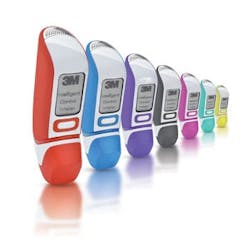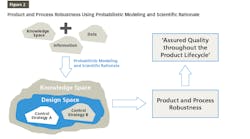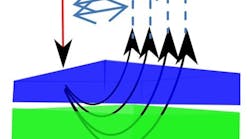The 3M Intelligent Control Inhaler provides on-screen instructions for use and feedback to the patient and health care provider via an app.
Inhalation therapy has been a mainstay treatment of asthma and chronic obstructive pulmonary disease (COPD) for over 60 years since the introduction of the metered dose inhaler (MDI). Since then, the industry has undergone constant evolution.MDIs are well known by patients and healthcare professionals alike. They are relatively low cost and highly portable. Since its introduction, the MDI has evolved significantly to include breath-actuation to ensure better patient coordination, as well as reformulation following the link between CFCs and ozone layer depletion. More recently, with the expiration of relevant patents, the generics market has been opened, allowing more cost-effective products to be launched. In 2015, for example, Sirdupla, a therapeutic equivalent of Seretide Evohaler was developed and launched by Mylan and 3M.
The rise of technology and smartphone apps has led to the introduction of high-tech devices with enhanced capabilities that offer many benefits from compliance, adherence and patient outcome points of view. Examples include: MD Turbo developed by Respirics, Propeller developed by Propeller Health, Smartinhaler developed by Adherium, and the 3M Intelligent Control Inhaler.
DEVELOPMENT FACTORS
When developing a new inhalation therapy product, the primary focus must be on ensuring that it is safe and efficacious and delivers the correct amount of medication over the stated shelf life. When patients, who may be in poor health, take their medication, they need to have complete confidence that as they take it, it will do what it says it will do without causing harm and with minimal side effects. The principles of Quality by Design (QbD) are applied to the formulation of new products to ensure robust products are developed.
When deciding on an inhalation dosage form, many factors need to be considered. These include: understanding the target site of action (including whether for local or systemic action), the dose that is required to achieve a meaningful therapeutic outcome, and the stability of the active pharmaceutical ingredients (APIs) in the delivery system.
When it comes to specific inhalation devices, there are pros and cons to consider between different types of devices. For example, MDIs are generally cheaper than dry powder inhalers (DPIs), and advances in patient training (e.g. using slow inspiratory flow) offer reproducible dosing to the patient. A criticism of MDIs has traditionally been determining when the device has reached the end of its life. However, the inclusion of dose counters in devices addresses this issue.
DPIs are sometimes considered to be easier to use, yet typically require a greater inspiratory effort than an MDI. This high resistance means that a sick patient (and especially pediatric and geriatric populations with compromised lung function) may not have sufficient inspiratory flow required to cause the device to function correctly. Also, different DPIs offer different air resistance, therefore meaning that different DPI devices require different use instructions. Due to the broad range of different DPI designs, there are challenges in developing information and instructions in support of the device.
Interactions in terms of both chemical and physical attributes are also key in developing a product. The drug product within the device must be chemically stable, so that it doesn’t break down and/or form degradation products that have toxicological issues. Physical attributes are also key. For example, drug particles that are suspended in an MDI formulation can grow over time if partial solubility is observed.
MDI DEVELOPMENT
During the development of MDIs, formulation options are assessed and developed based on a defined, scientific approach. The aim is to repeatedly demonstrate, with meaningful analytical methods, that the formulation is capable of meeting the required product performance criteria. In light of the range of components within a MDI system, all of these should be optimized and understood.
Similarly, excipient characterization is performed on potential excipient options. Excipients may be required for a variety of reasons, for example, to ensure drug stability or dosing repeatability.
Pre-formulation activities will be completed by performing studies to determine the solubility of the API in potential Hydrofluoroalkane (HFA)-based systems and to assess the potential formulation routes. Such studies, for example, would determine whether the product is formulated as a suspension or solution-based system.
If an MDI is formulated as a suspension, the particle size distribution (PSD) of the API is a key performance driver. Particles for inhalation need to be in the range 1-5mcm in order to target the appropriate area of the lung. Typically, the PSD is at the lower end of this range. For a solution-based product, the input PSD of the input API is less critical, since the aerosolization of the drug is determined by other parameters.
MANUFACTURING PROCESS
Consideration also has to be given to the manufacturing process. For MDIs, there are essentially two main methods of filling employed globally today: cold filling and pressure filling.
In cold filling, a concentrate of drug and excipients are mixed with the liquefied propellant at low temperature within the batching vessel. The formulation is then dispensed directly in a single filling step into the empty pMDI canister and the metering valve is then crimped into place.
In pressure filling, a concentrate of drug and excipients is mixed with the volatile propellant under pressure within the batching vessel at near ambient temperature. The whole formulation is then injected through a pre-crimped metering valve and canister. As pressure filling relies on filling the formulation backwards through the valve at high pressure, as opposed to the normal patient-use operation in which the valve opens to allow formulation out of the canister, metering valves have to be designed with this in mind.
Once formulation options have been developed and a manufacturing process identified, the development of a product continues. Proof of Concept and Phase I clinical activities may be performed, based on a thorough understanding of the product performance versus requirements.
Further development activities involve defining and optimizing the design space, understanding critical parameters and establishing acceptable working ranges. In parallel, the manufacturing process should be appropriately validated and specifications determined in preparation for a regulatory submission.
Clinical and stability data are generated to further define the product design space in preparation for later development and product registration. The final stages include the development of a robust product and manufacturing process, performing Development Pharmaceutics studies and the supply of Phase II / III clinical material.
EVOLUTION CONTINUES
Inhalers are typically at this time used to deliver drugs locally to the lung for the treatment of asthma and COPD. However, there is also a growing area of systemic drug delivery via these dosage forms, for example, insulin via the lung. There is also work being done in formulation for devices targeting areas of the body that have traditionally been difficult to target. One recent example is the delivery of drug to the brain via intra-nasal delivery. When trying to deliver to non-topical sites, various excipients might be assessed to enhance absorption.
Inhalation therapy has developed significantly over the decades and there is no doubt the evolution will continue. The opportunities to improve quality of life for patients are seemingly endless. It is exciting to think about where the industry will be in another 60 years.





